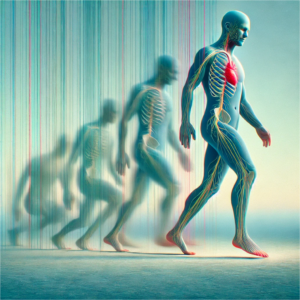Move to safety, Connection and Regulation
Neuroceptive Learning acknowledges the link between events leading to C-PTSD, learning difficulties, chronic health and behavioural conditions, and nervous system dysregulation. Our approach does not pathologise or label but optimises nervous system regulation, co-regulation, and self-regulation. The key to the functioning of our nervous system is neuroception, which is the subconscious evaluation of sensory information from our bodies and environment.
Our nervous system functions from the bottom up: from the body to the brain and within the brain, from the subconscious (brainstem) to conscious cognition (thinking prefrontal cortex).
In between, neuroception occurs, subconsciously evaluating sensory information. Neuroception influences whether our nervous system regulates our health with access to higher cortical input and thus affects our ontology: who we are in our doing, being, becoming, belonging, connection to our soul values, experience of psychological safety in the world, and realisation of our potential.
The sensory-motor component of our nervous system conveys afferent (sensory) and efferent (motor) information to and from our brains via spinal and cranial nerves. Our internal interoception, proprioception, and vestibular senses, along with our five senses of hearing, vision, touch, smell, and taste, convey our unique history (ontogeny) embodied in our nervous system and body to our brain for sensory processing and integration.
The vestibulocochlear nerve (cranial nerve VIII) and the vagus nerve (cranial nerve X) play an important role in the sensory integration process. The myelinated vestibular system facilitates gravitational security – our ongoing sense of safety and stability within the gravitational field—and is vital in integrating our other senses. The vagus nerve is the only cranial nerve travelling down into our bodies, conveying an embodied ontogenetic sensory history to our brain. From the Polyvagal Theory, we also know that the myelinated ventral vagus nerve facilitates and provides our connection response through our face-heart complex of cranial nerves (V, VII, IX, X, XI) and by providing the vagal brake, which can down-regulate protective reactive responses.
Furthermore, 80% of the vagus nerve fibres are sensory (from the body to the brain), and only 20% are motor (from the brain to the body), indicating the importance of sensory integration and processing alongside cognition. It also shows that we can influence neuroception through sensory input.
Due to the bottom-up functioning of our nervous system, we can influence neuroception through the sensory-motor part of the nervous system. By sending different sensory information to the brain, we can facilitate the formation of new neuropathways.
At Neuroceptive Learning, we use different Reflex Integration and Rhythmic Movement Training approaches to promote neuroplastic learning. These movement-based, primitive (infant or neonatal) reflex integration programmes use developmental movements, gentle isometric pressure, and self-awareness to rebuild the foundations necessary to help children and adults overcome learning, sensory, emotional, and behavioural challenges.
All human babies make certain spontaneous movement responses to specific stimuli in the womb and during the first years of life. These reflex movements are involuntary and automatic, supporting growth, nerve, and muscle development as we become upright within the gravitational field.
Not only are basic motor skills learned through these innate responses (reflexes) to specific sensory stimuli, but connections between the brain and the body are strengthened, and vital synapses within the brain itself are formed. This facilitates the development of our vision, hearing, feeling, thinking, acting, balance, coordination, and perception as the prefrontal cortex exercises increased control over planning purposeful movement and behaviour, flexibility of response to sensory stimuli, and develops language and executive functioning.
“Movement is our first language.”
Sally Goddard
Certain reflexes, called primitive reflexes, should only be present in the first few months of life and should integrate as more permanent postural reflexes come online to help the individual cope and feel safe within the gravitational field and develop good coordination with continued central nervous system maturation.
Our unique ontogenetic history, prolonged stress, burnout, and traumas may cause previously integrated primitive reflexes to become “active” again, or they might not have been optimally integrated to start with, resulting in gravitational insecurity, our neuroception becoming biased towards unsafe evaluation, and our autonomic nervous system becoming dysregulated. Similarly, our face-heart connection sending interoceptive information via our vagus nerve to our brainstem may also become suboptimal and contribute to biased neuroception.
I have trained in different rhythmic movement integration modalities and integrate these with my service offerings:
- Blomberg Rhythmic Movement Training, developed by Dr Harald Blomberg, uses spontaneous rhythmic infant movements to enhance motor skills and overall development. It benefits individuals with varying challenges by improving motor abilities, coordination, muscle tone, and reflex integration. Beyond motor skills, improvements in speech, vision, and attention are observed. These gains stem from rhythmic exercises stimulating and connecting different brain areas.
- Institute for Neuro-Physiological Psychology (INPP method): Every child is born with reflexes that should integrate within the first year. If these persist, they hinder motor, visual, and perceptual development, causing learning barriers. INPP identifies central nervous system immaturity as a learning barrier linked to concentration issues, frustration, and underachievement. INPP offers a drug-free, non-invasive solution to help children succeed by addressing these challenges.
- KinFlex® Kinesiological Reflex Therapy combines Reflex Integration with kinesiology into one effective therapy to de-stress and centre physical and emotional symptoms stemming from early childhood.
- BRAIN GYM® promotes learning through playful activities. It was developed by Dr Paul Dennison, the originator of Educational Kinesiology, and his wife, Gail. Brain Gym activities were developed from his understanding of the impact of movement and perception on fine motor and academic skills, his training as a marathon runner, his work with developmental optometrists doing vision training, and his study of Jin Shin Jyutsu (a form of acupressure).
- Neuroscanbalance®, based on the Feldenkrais Method and Anat Baniel Neuromovement Program, follows the progression of our reflexes from birth onwards to form new neuropathways in our brains.
At Neuroceptive Learning, we integrate these modalities to support individuals in restoring balance, enhancing neuroception, and promoting overall well-being through neuroplasticity and nervous system regulation.


